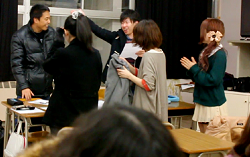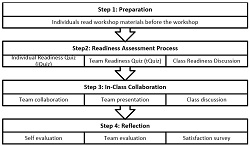Team Hachi Project
Thirty student volunteers joined researchers in a simulated four-week course at a private university in Northeast Japan to participate in a collaborative action research project for assessing the viability of team learning in Japanese higher education. Typical for Japanese higher education, small-group learning was a foreign concept for the university and student volunteers (Imafuku, Kurata, Kataoka, & Mayahara, 2010). Despite living in a culture that holds cooperation and collaboration as core values (Nagao, Takashi, & Okuda, 2011), the college experience for the students at the university was like that in other Japanese higher education institutions. In short, while students attend class with other students, they are essentially isolated among others in didactic lecture-test learning environments that do not allow collaboration among students in the classroom (Tsuneyoshi, 2001). The collaborative activities students have with others typically takes place during extracurricular activities and on-the-job training after graduation.
In addition to their lack of experience with small group learning activities in their classrooms, professors had told researchers that the students were too remedial, unskilled, unmotivated, and reserved to learn through mutual development (Duncan, 2018). This laid the challenge for Team Hachi Project, a collaborative action research project to assess the viability of team learning with students in a private community college in northeastern Japan.
Design
Starting with the hypothesis that remedial college students in a rural community college could increase academic performance and satisfaction through small-group learning methods, researchers invited students to act as co-researchers in a collaborative action research project that would simulate a small-group learning environment. Integrating concepts from Team-Based Learning (Michaelsen, 2004) with a work-team model designed for university students, researchers created a process and curriculum that applied Hackman’s dimensions of group effectiveness with action research.
Hackman’s dimensions of group effectiveness
Researchers used the dimensions of group effectiveness defined by Richard J. Hackman (1992) to measure results as follows:
- Goal Attainment. An effective group completes its tasks and accomplishes its goals.
- Satisfaction. Members of the group are satisfied with the process.
- Continuance and persistence. Members of the group are willing to continue working with the group or repeat the process.
Action research
The action research design consisted of four one-week research cycles in a simulated classroom, applying the following phases in each workshop (see Figure 1):
- Preparation. The students prepared for each workshop by reading assigned materials.
- Readiness assessment. Students started each workshop by taking a quiz to assess their level of knowledge and readiness to engage in small-group activities.
- Collaboration. Each student joined a learning team of four other students to discuss the same questions and concepts covered in the readings and readiness assessment to complete the quiz as a group. The comparison between individual and team scores became data to indicate individual learning levels through collaboration. The faculty reviewed the results to identify opportunities for reinforcing and realigning learning in a class discussion. After the discussion, the faculty assigned the teams a project to develop based on the workshop materials, assessments, and discussions. Each team prepared a brief presentation of their project to the class.
- Reflection. At the end of each research cycle, each student completed an evaluation form and satisfaction survey to reflect on what they had learned, record their perceptions of individual and group learning, share their satisfaction with the outcomes, and offer recommendations for improving subsequent cycles.
- Adjust. Researchers evaluated the results of each cycle to identify opportunities for improving the subsequent cycle.

Practice
Each phase in a research cycle provides researchers with opportunities to apply various levels of attention events designed to scaffold individuals and groups to accept increasing levels of interdependence in learning and performance. Based on a technique suggested by Lev Vygotskiǐ (1978), scaffolding means that the teacher acts as a mentor or coach who carefully guides a mentee through the initial stages of learning, gradually removes support so the student can practice toward mastery, then repeats the cycle of engagement to facilitate increasingly higher levels of performance.
Gerald Grow (1996) suggested a practical scaffolding framework in his Self-Directed Learning Model, which applies situational leadership approaches in the classroom for adjusting faculty support based on the readiness and ability of learners to facilitate students toward self-direction in learning.
Applied to a small-group learning environment, the teacher gauges his or her involvement based on the team’s “zone of proximal development” (Vygotskiǐ, p. 86), meaning their readiness to perform the required tasks (Grow, 1996). As the members increase in performance through interdependence, the teacher removes support. In other words, the teacher engages to the degree of the student’s inability. The teacher’s levels of engagement may shift throughout a course to do the following:
- Help individual students acquire and demonstrate the basic knowledge for participating in group activities.
- Provide individuals and groups with the training and tools to work together in teams.
- Administer the coaching necessary to help teams engage in mutual development.
- Withdraw support to observe the students practice, fail, and adjust independently.
- Assert support as necessary to reinforce or realign learning and foster higher performance levels.
Results
Team Hachi Project researchers gathered qualitative and quantitative data using a combination of classroom assessments, weekly surveys, interviews with students, and video analysis. Consolidating all four cycles of quantitative data from assessments and surveys (see Figure 2):
- Participants reported 93% of the time that they learned more with their teams than alone; a paired t-test supported this finding by showing 98% confidence that students performed better on team tests than when taking the same test alone.
- Participants increased satisfaction with their individual and team performance with each research cycle. Overall, students were satisfied with individual performance 78% of the time and team performance 83% of the time.
- Participants preferred team learning over lectures 86% of the time, with 83% saying they wanted team learning in their regular courses.
- Each measure improved from 7% to 20% in each subsequent cycle.
Integrating with the quantitative data the qualitative information from observations, video analysis, and discussions with students, researchers concluded the following:
- Remedial college students can increase academic performance and satisfaction through small-group learning methods.
- Participants demonstrated the capacity to adapt and perform in a small-group learning environment.
- Students are eager to learn through dialog with one another and in collaboration with their teachers.
- While students appear willing and able to succeed in small-group learning environments, institutional culture and instructor skills remain barriers.
Follow-up interviews indicated that the experience had a transformational effect on some participants, with almost all crediting the experience for helping them develop the confidence and skills necessary to acquire good jobs. Also, all students who started the action research project persisted through the entire four weeks of research cycles and increased engagement with each research cycle (Duncan, 2013).
After the project's conclusion, demand from former participants and other students encouraged the University to repeat the study each semester as a formal series of developmental workshops for students (Duncan, 2013). The second series of workshops had more than one hundred volunteers with comparable results; eight of the students from the original research project volunteered to serve as mentors in the subsequent research cycles.
Through the perspective of Hackman’s (1992) dimensions of group effectiveness (goal attainment), the students achieved the goals of the experiment, were satisfied with the process (satisfaction), and had an increased ability to persist and a strong desire to continue (continuance).

Figure 2. The survey summary shows elevated levels of perceived performance and satisfaction.




